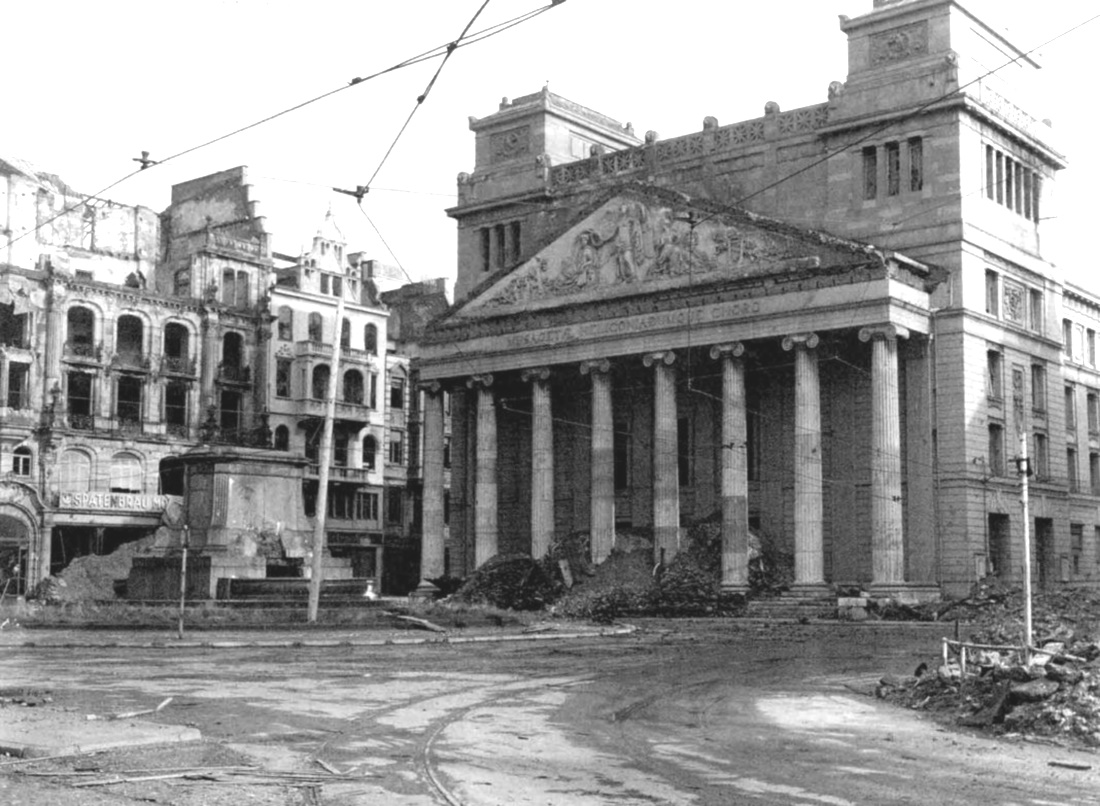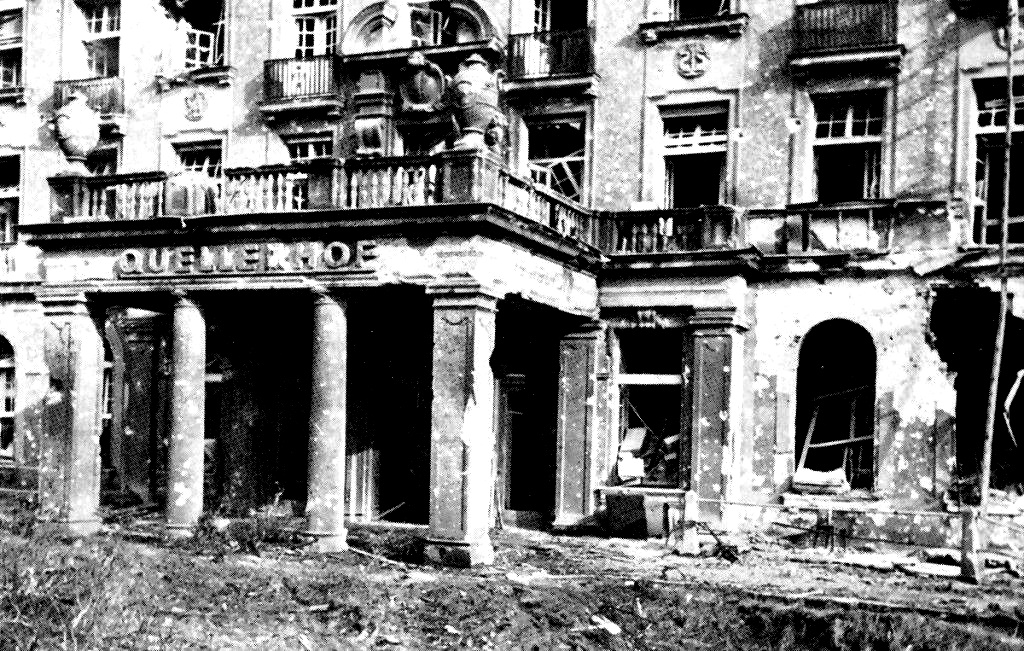Document Source: Operations of the 2nd Battalion, 26th Infantry Regiment, 1st Infantry Division in Aachen, Germany, October 10 – 21 1944
Lt Col D. M. Daniel, (Personal Experience as a Battalion Commander)

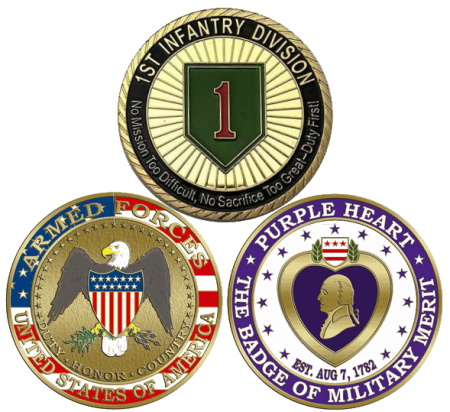 To understand the operations at Aachen, it is necessary to begin in the vicinity of Mons, Belgium. There, remnants of the XV German Army were, from their positions along the north coast of France, attempting to escape from the pocket caused by the rapid advances of the US 1-A and the UK 2-A. By Sept 2, at least five German divisions, under orders to pull out and beat the Americans to the Siegfried Line, were well on their way to the east when they ran into the flank of the American 3-AD. As they tried to push their way through, the US 1-ID struck their south flank. During the next five days, when there were no front lines and all units of these two American divisions were actually fighting in all directions, over 22.000 prisoners were captured and a disproportionately high number of dead had been buried in the field.
To understand the operations at Aachen, it is necessary to begin in the vicinity of Mons, Belgium. There, remnants of the XV German Army were, from their positions along the north coast of France, attempting to escape from the pocket caused by the rapid advances of the US 1-A and the UK 2-A. By Sept 2, at least five German divisions, under orders to pull out and beat the Americans to the Siegfried Line, were well on their way to the east when they ran into the flank of the American 3-AD. As they tried to push their way through, the US 1-ID struck their south flank. During the next five days, when there were no front lines and all units of these two American divisions were actually fighting in all directions, over 22.000 prisoners were captured and a disproportionately high number of dead had been buried in the field.
Operations at Aachen

 On Sept 7, 1944, the 1-ID (Big Red One – Gen Clarence M. Huebner) turned east from Mons and by Sept 12, had cleared through Namur and Liège, and had pushed into the Siegfried Line southwest of Aachen. Instead of driving directly into the city in mid-September, the division side-slipped the bulk of its forces to the east, to complete the penetration of the Siegfried Line eastward of the city and isolate it prior to a direct attack. One recalls that about this time gasoline had become a very critical item, affecting operations of the US 1-A as well as that of the US 3-A. Quite literally all-action became ‘foot’ action. By Oct 10, the encircling forces had almost accomplished the entire surrounding of the city, although there was still a gap of about a mile and Aachen was not definitely ‘cut off’.
On Sept 7, 1944, the 1-ID (Big Red One – Gen Clarence M. Huebner) turned east from Mons and by Sept 12, had cleared through Namur and Liège, and had pushed into the Siegfried Line southwest of Aachen. Instead of driving directly into the city in mid-September, the division side-slipped the bulk of its forces to the east, to complete the penetration of the Siegfried Line eastward of the city and isolate it prior to a direct attack. One recalls that about this time gasoline had become a very critical item, affecting operations of the US 1-A as well as that of the US 3-A. Quite literally all-action became ‘foot’ action. By Oct 10, the encircling forces had almost accomplished the entire surrounding of the city, although there was still a gap of about a mile and Aachen was not definitely ‘cut off’.

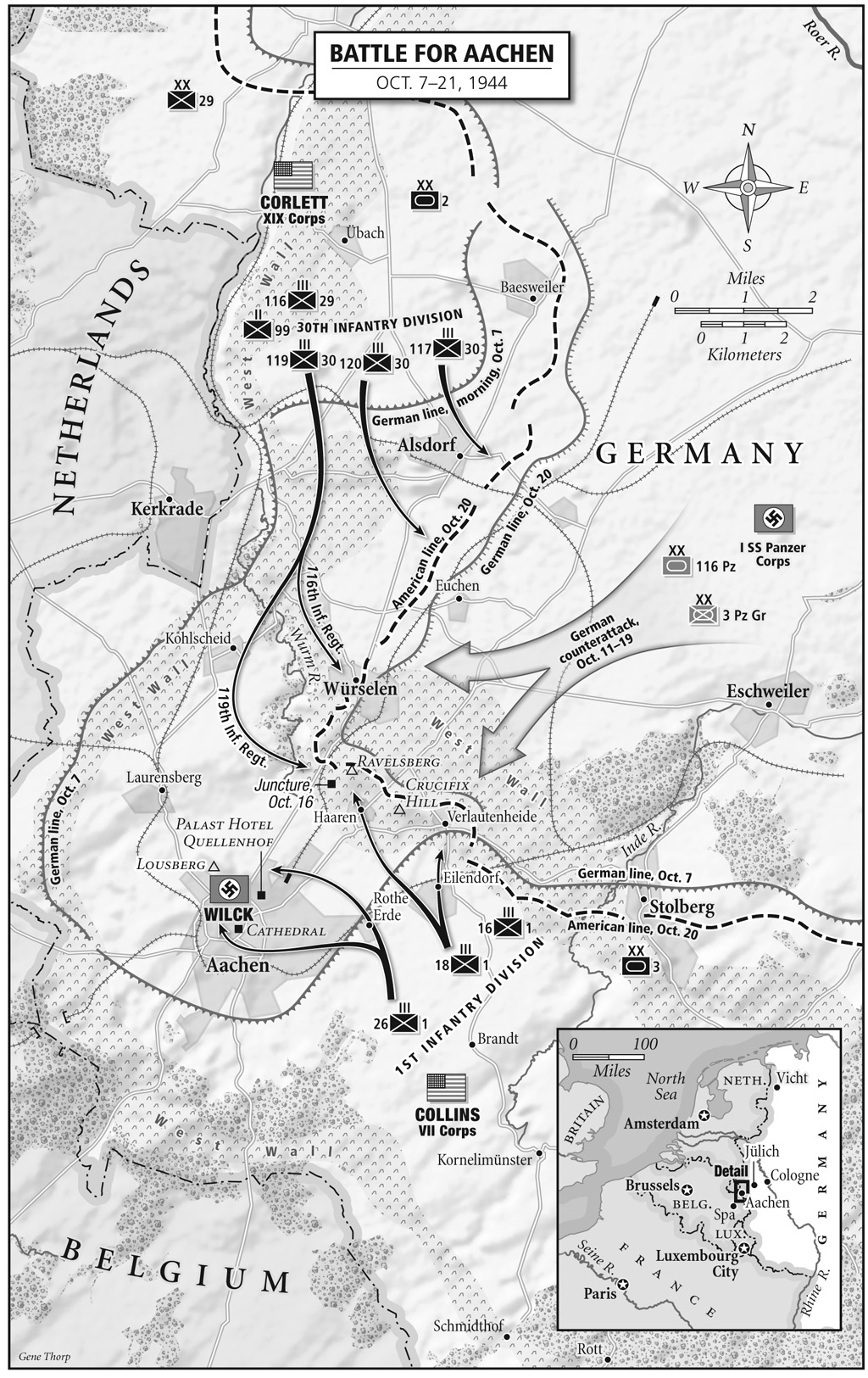 The US VII Corps Commander, Gen J. Lawton Collins, ordered an ultimatum delivered to the city. This document promised the complete destruction of the city if it was not surrendered unconditionally within 24 hours.
The US VII Corps Commander, Gen J. Lawton Collins, ordered an ultimatum delivered to the city. This document promised the complete destruction of the city if it was not surrendered unconditionally within 24 hours.
 With all roads running to Aachen cut and all-terrain surrounding it commanded by American guns, the city was warned yesterday to surrender unconditionally within 24 hours or be destroyed. In an ultimatum brought into the besieged city at 1045 by two lieutenants escorted by a private bearing a white flag, the commander of the isolated Nazi garrison was told: The city of Aachen now is completely surrounded by American forces who are sufficiently equipped with both air power and artillery to destroy the city if necessary. We shall take the city either by receiving its unconditional surrender or by attacking and destroying it.
With all roads running to Aachen cut and all-terrain surrounding it commanded by American guns, the city was warned yesterday to surrender unconditionally within 24 hours or be destroyed. In an ultimatum brought into the besieged city at 1045 by two lieutenants escorted by a private bearing a white flag, the commander of the isolated Nazi garrison was told: The city of Aachen now is completely surrounded by American forces who are sufficiently equipped with both air power and artillery to destroy the city if necessary. We shall take the city either by receiving its unconditional surrender or by attacking and destroying it.
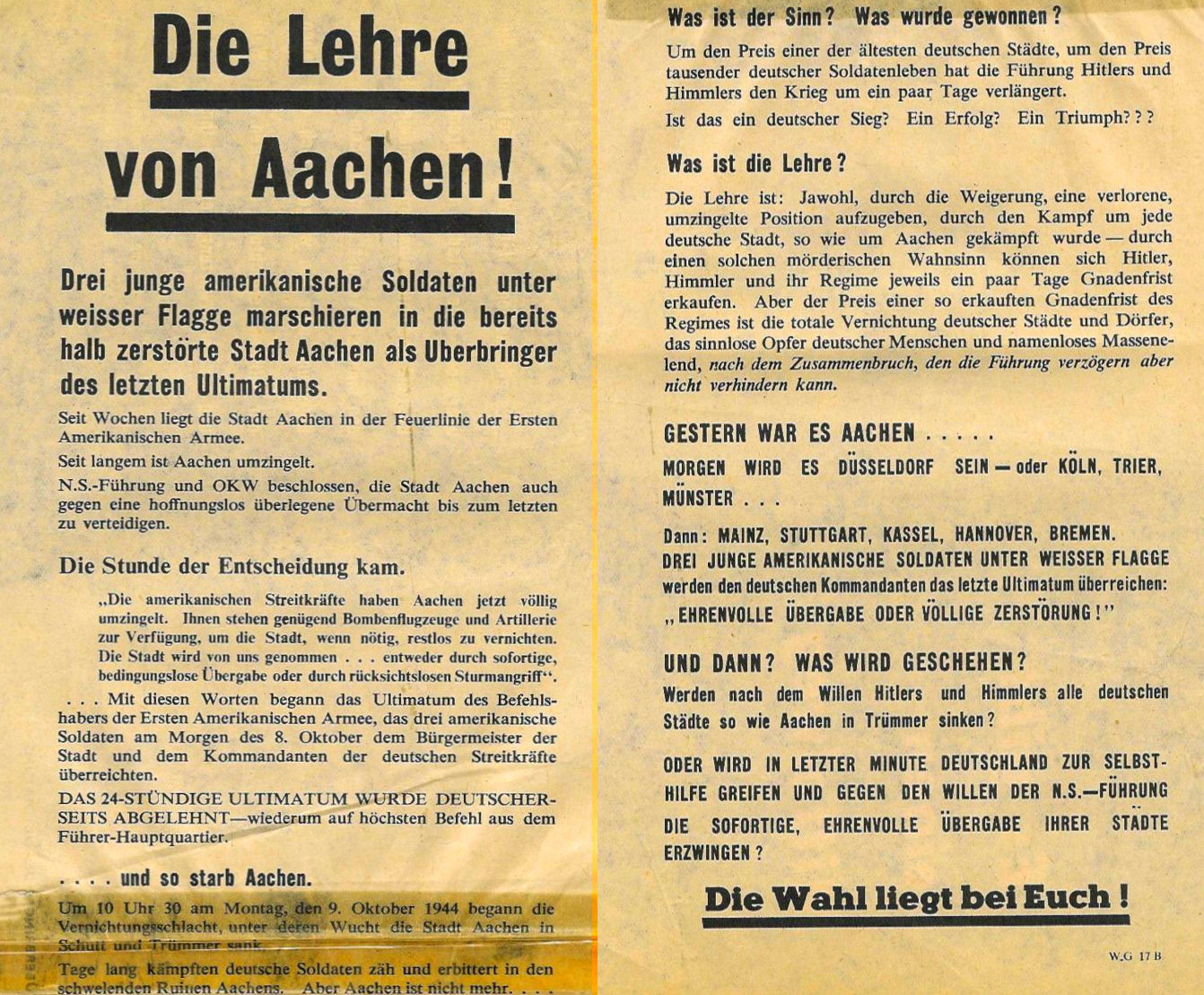 Leaflets showered on the city, the Associated Press reported, informed civilians and troops within the city that on our airfields bombers are awaiting final orders to take off. Our artillery surrounding the city is ready. Our troops are alerted for the final advance. Last night, the Nazis still were bitterly defending Aachen and the Nazi commander had not answered the US ultimatum. However, the commander of one enemy company northwest of the city had asked for safe conduct passes for himself and his troops, a United Press dispatch said. While the First Army massed before Aachen and, according to front-line reports, narrowed the city’s escape gap to one mile, Americans and French of the Sixth Army Group were engaged in sharp clashes with Germans protecting the southern approaches to the Reich.
Leaflets showered on the city, the Associated Press reported, informed civilians and troops within the city that on our airfields bombers are awaiting final orders to take off. Our artillery surrounding the city is ready. Our troops are alerted for the final advance. Last night, the Nazis still were bitterly defending Aachen and the Nazi commander had not answered the US ultimatum. However, the commander of one enemy company northwest of the city had asked for safe conduct passes for himself and his troops, a United Press dispatch said. While the First Army massed before Aachen and, according to front-line reports, narrowed the city’s escape gap to one mile, Americans and French of the Sixth Army Group were engaged in sharp clashes with Germans protecting the southern approaches to the Reich.
No one was particularly surprised when no answer was received, although the German radio said it had been rejected. Unofficially, however, civilians indicated that word of the ultimatum had passed around by showing white flags at many points in the city.
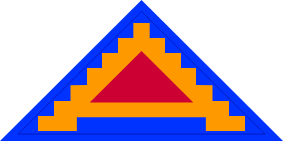
 West Front with the US 7-A. Together they comprise the 6-AG. Previously it had been announced merely that French troops were fighting with the Americans. Liberating or by-passing more than a dozen villages, the US 3-A (Gen George S. Patton) eliminated a German bulge in the line between Metz and Nancy and occupied new positions running from Fresnes-en-Saulois, 15 miles northeast of Nancy, to Cheminot, 18 miles north of Nancy.
West Front with the US 7-A. Together they comprise the 6-AG. Previously it had been announced merely that French troops were fighting with the Americans. Liberating or by-passing more than a dozen villages, the US 3-A (Gen George S. Patton) eliminated a German bulge in the line between Metz and Nancy and occupied new positions running from Fresnes-en-Saulois, 15 miles northeast of Nancy, to Cheminot, 18 miles north of Nancy.
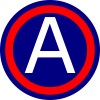
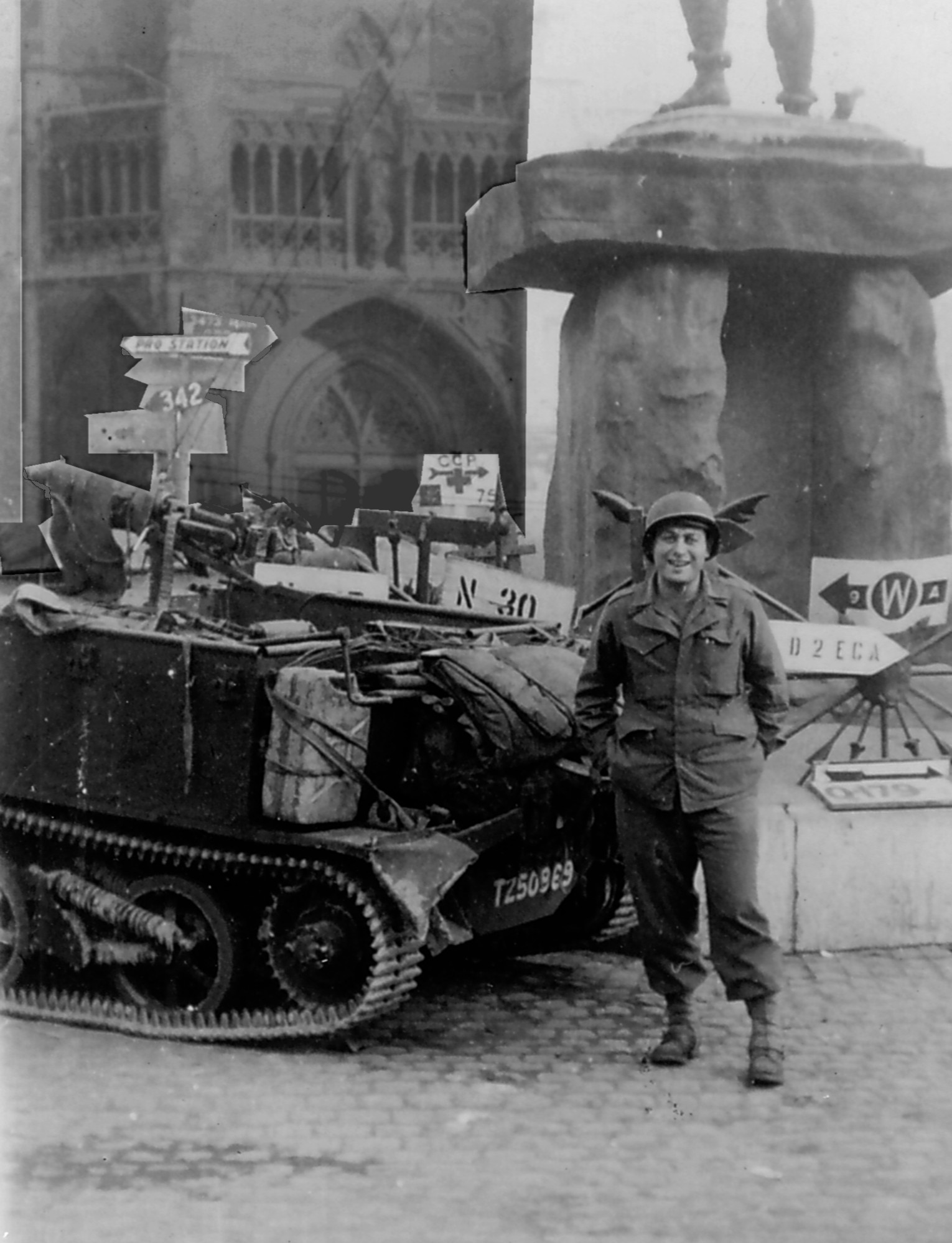 Six miles north of Metz, Gen George S. Patton’s forces occupied the southern part of the town of Mazières-les-Metz. Within Fort Driant there was no change in American or German positions, but Fort Marival, one mile north of Driant, from which fire has been directed on US troops, was shelled. Other 3-A doughboys liberated the town of Létricourt, about 12 miles north of Nancy, Canadians who landed on the south shore of the Scheldt Estuary, extended their bridgeheads behind the enemy lines but did not link up. Between the new bridgeheads and the old bridgehead over the Leopold Canal, which now is roughly four miles long and one mile deep, about 10.000 Germans are being squeezed. British troops repulsed a sharp enemy attack against Dutch salient between the Neder Rhine and the Waal Rivers in the neighborhood of Dodewaard, about ten miles northwest of Nijmegen.
Six miles north of Metz, Gen George S. Patton’s forces occupied the southern part of the town of Mazières-les-Metz. Within Fort Driant there was no change in American or German positions, but Fort Marival, one mile north of Driant, from which fire has been directed on US troops, was shelled. Other 3-A doughboys liberated the town of Létricourt, about 12 miles north of Nancy, Canadians who landed on the south shore of the Scheldt Estuary, extended their bridgeheads behind the enemy lines but did not link up. Between the new bridgeheads and the old bridgehead over the Leopold Canal, which now is roughly four miles long and one mile deep, about 10.000 Germans are being squeezed. British troops repulsed a sharp enemy attack against Dutch salient between the Neder Rhine and the Waal Rivers in the neighborhood of Dodewaard, about ten miles northwest of Nijmegen.
The Lesson from Aachen!
 Three young American soldiers under a white flag march into the half-destroyed city of Aachen as bearers of the final ultimatum. For weeks the city of Aachen has been lying in the firing line of the US 1-A. For a long time, Aachen has been surrounded. The National Socialist leadership and the OKW decided to defend the city of Aachen even against a hopelessly superior superpower to the bitter end. The time for the decision came. The American forces have now completely surrounded Aachen. They are supplied with enough bombers and artillery to decimate the city, if necessary. The city will be seized by us … either through immediate, unconditional surrender or through ruthless attack. With these words, the ultimatum of the commander of the US 1-A, Gen Courtney Hodges began the ultimatum which three American soldiers delivered to the mayor of the city and the commander of the German Forces on the morning of Oct 8. The Germans rejected the 24-hour ultimatum – once again on highest orders from Hitler-headquarters … and so Aachen died. On Monday, Oct 9, 1944, at 1030, the devastating battle began, through which the city of Aachen was reduced to rubble. For days, German soldiers tenaciously and bitterly fought in the smoldering ruins of Aachen. But Aachen does not exist anymore…
Three young American soldiers under a white flag march into the half-destroyed city of Aachen as bearers of the final ultimatum. For weeks the city of Aachen has been lying in the firing line of the US 1-A. For a long time, Aachen has been surrounded. The National Socialist leadership and the OKW decided to defend the city of Aachen even against a hopelessly superior superpower to the bitter end. The time for the decision came. The American forces have now completely surrounded Aachen. They are supplied with enough bombers and artillery to decimate the city, if necessary. The city will be seized by us … either through immediate, unconditional surrender or through ruthless attack. With these words, the ultimatum of the commander of the US 1-A, Gen Courtney Hodges began the ultimatum which three American soldiers delivered to the mayor of the city and the commander of the German Forces on the morning of Oct 8. The Germans rejected the 24-hour ultimatum – once again on highest orders from Hitler-headquarters … and so Aachen died. On Monday, Oct 9, 1944, at 1030, the devastating battle began, through which the city of Aachen was reduced to rubble. For days, German soldiers tenaciously and bitterly fought in the smoldering ruins of Aachen. But Aachen does not exist anymore…
What is the point? What was gained?
At the cost of one of the oldest German cities, at the cost of thousands of German soldiers’ lives, the Hitler and Himmler regime prolonged the war by a couple of days. Is that a German victory? A success? A triumph? What is the lesson?
 The lesson is: yes, by refusing to surrender a hopeless, encircled position, by fighting for every German city, as at Aachen – through such murderous insanity, Hitler, Himmler and their regime can buy themselves a few days reprieve each time. But the price of such a reprieve for the regime is the complete destruction of German cities and villages, the meaningless sacrifice of German people, and unspeakable widespread misery after the collapse, which the regime can delay, but not prevent.
The lesson is: yes, by refusing to surrender a hopeless, encircled position, by fighting for every German city, as at Aachen – through such murderous insanity, Hitler, Himmler and their regime can buy themselves a few days reprieve each time. But the price of such a reprieve for the regime is the complete destruction of German cities and villages, the meaningless sacrifice of German people, and unspeakable widespread misery after the collapse, which the regime can delay, but not prevent.
Yesterday it was Aachen. Tomorrow, it will be Düsseldorf or Köln, Trier, Münster … Then : Mainz, Stuttgart, Kassel, Hannover, Bremen. Three young American Soldiers under a white flag will hand the German Commander the final ultimatum: Honorable Surrender or Complete Destruction! And then? What will happen? Will, according to Hitler’s and Himmler’s will, all German cities be reduced to rubble like Aachen? Or, in the last minute, will Germany help itself and force, against the will of the National-Socialist Leadership, the immediate, honorable surrender of its cities? The decision is yours!
No mention has been made of the bitter fighting encountered by the encircling troops in reaching the positions on Oct 10, nor of the constant and violent counterattacks which they had to beat off after that date in order to hold those positions. While those actions had quite a definite influence on the capture of the city they are not within the scope of this account.


 By Oct 10, the stage had been set and the 26-IR (1-ID) was on the stage ready to begin the actual reduction (and as the ultimatum stated), the destruction of the city. Since before the Mons episode, the 26-IR had been fighting with only the 2/26-IR and the 3/26-IR, the 1/26-IR having been attached to the 3-AD, when the bulk of the 1-ID began side slipping to the east around Aachen it became apparent to even the lowest ranking soldier that the 26-IR was going to be charged with the actual reduction of the city. And when the 3/26-IR also was side-slipped away around to the east of the city on Oct 11, it was clear to everyone in the 2/26-IR that they would have the honor of house-to-house fighting in the the city proper.
By Oct 10, the stage had been set and the 26-IR (1-ID) was on the stage ready to begin the actual reduction (and as the ultimatum stated), the destruction of the city. Since before the Mons episode, the 26-IR had been fighting with only the 2/26-IR and the 3/26-IR, the 1/26-IR having been attached to the 3-AD, when the bulk of the 1-ID began side slipping to the east around Aachen it became apparent to even the lowest ranking soldier that the 26-IR was going to be charged with the actual reduction of the city. And when the 3/26-IR also was side-slipped away around to the east of the city on Oct 11, it was clear to everyone in the 2/26-IR that they would have the honor of house-to-house fighting in the the city proper.
Many days before we had begun discussing this problem in the 2/26-IR and we could not help recalling with some apprehension all that we had heard about the Battle in Monte Cassino. Although we believed that the quality of the German troops garrisoning Aachen was not of the best, we were certain that even a poor soldier can be a formidable opponent in house-to-house and pillbox fighting, particularly when defending so prominent a city or the Fatherland.
Planning
In approaching the problem of clearing the city of Aachen the battalion commander considered it in three phases: Planning, deployment or organization for combat, and the assault of the town. The general plan evolved was to use artillery and mortar fire across our front to isolate the sector, thus preventing Germans from entering (or for that matter, from leaving) the area under attack; then to use direct fire from tanks, tank destroyers, and machine guns to pin down the defenders and chase them into cellars; and then to move in with bayonets and hand grenades. to destroy or capture the defenders. We continuously impressed upon all individuals the necessity for keeping up a continuous stream of fire with all available weapons. We coined a slogan, Knock ‘Em All Down’; which became a battle cry because the soldiers were quick to realize that the defenders could hardly deliver accurate fire with buildings falling about their ears. We practiced this with marked success by making platoon. raids on houses known to be occupied by the enemy.

 In our planning, we foresaw several difficulties. Chief among them were the unusually large quantities of ammunition required, the coordination between and control of units in, street fighting, the problem of civilians, and the use of Tanks and Tank Destroyers without undue exposure to AT weapons. To meet these problems we established a battalion ammunition dump, stocked with all types of ammunition for all weapons in the battalion and attached units. We planned to keep moving this dump so that units would always have ammunition immediately at hand. We worked out a system whereby all street intersections and all-important buildings were numbered so that it would be easy to report exact locations accurately and quickly.
In our planning, we foresaw several difficulties. Chief among them were the unusually large quantities of ammunition required, the coordination between and control of units in, street fighting, the problem of civilians, and the use of Tanks and Tank Destroyers without undue exposure to AT weapons. To meet these problems we established a battalion ammunition dump, stocked with all types of ammunition for all weapons in the battalion and attached units. We planned to keep moving this dump so that units would always have ammunition immediately at hand. We worked out a system whereby all street intersections and all-important buildings were numbered so that it would be easy to report exact locations accurately and quickly.
Constant positive liaison between units was required. The problem of what to do with the thousands of civilians known to be still in the city was acute. If they were not evacuated as we overran their abodes the chances for German soldiers to masquerade as civilians behind our lines would be quite great. We decided therefore that the way to clean out an enemy city was to clear everyone, civilian and soldier, from each building before passing on to the next. We planned to search every building, every room, every closet, every cellar, even the manholes in the street, to be absolutely certain that no one was behind our front lines. We knew this would be a very slow process but the only alternative we could see was to be subjected to sniping from our rear.
 Tanks and TD’s in street fighting of course have to use the streets. We planned to place the tanks on side streets, have their nose around the corners firing all guns to aid the infantry to get forward. As soon as another side street was cleared we planned to smother all possible AT gun sites commanding the axial street, then rush the tanks to the next side street and continue the above process. Deployment and organization for combat, each of the three rifle companies were made a small task force by attaching to it three tanks or TD’s, two 57-MM AT guns, two bazooka teams (in addition to their own), one flame thrower, and two heavy machine guns. Since Aachen had a pré-war population of 160.000, it was evident that all three companies would have to be used in the assault and any reserve forces would have to be furnished by higher headquarters.
Tanks and TD’s in street fighting of course have to use the streets. We planned to place the tanks on side streets, have their nose around the corners firing all guns to aid the infantry to get forward. As soon as another side street was cleared we planned to smother all possible AT gun sites commanding the axial street, then rush the tanks to the next side street and continue the above process. Deployment and organization for combat, each of the three rifle companies were made a small task force by attaching to it three tanks or TD’s, two 57-MM AT guns, two bazooka teams (in addition to their own), one flame thrower, and two heavy machine guns. Since Aachen had a pré-war population of 160.000, it was evident that all three companies would have to be used in the assault and any reserve forces would have to be furnished by higher headquarters.
Aachen, the Assault of the City
When the ultimatum was delivered on Oct 10, the 2/26-IR, was still about a one-half mile southeast of the limits of the city proper.
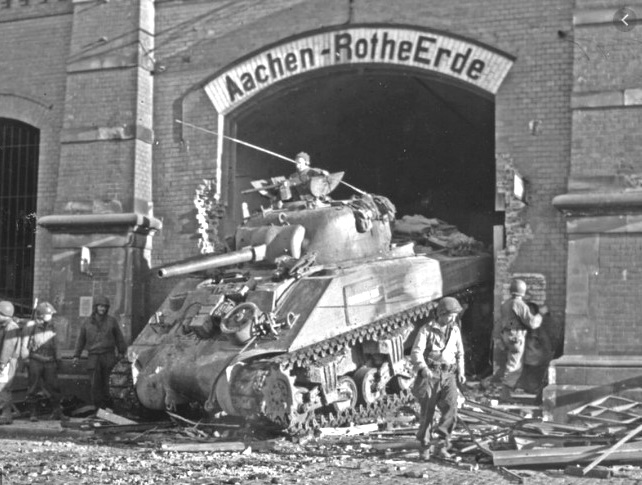 When it expired, a days later, the aerial and artillery bombardment commenced. The 3/26 left one company on our left flank and moved the remainder around east to Rothe-Erde to capture the high ground northeast of Aachen and to prepare to attack the factory district between that point and the city. On Oct 12, one company of the 1/26 was released to the 26-IR to cover the south approaches to the city. This released the remaining company of the 3/26 to assist in their attack. The 3/26 then jumped off at 1100 on Oct 12, quickly reached its objective, and began mopping up. During this time the 2/26 moved forward to the railroad track on the southeast side of Aachen, clearing quite a built-up area with house-to-house fighting. Needless to say, all the artillery with the Corps that could be brought to bear was continuously pounding the city.
When it expired, a days later, the aerial and artillery bombardment commenced. The 3/26 left one company on our left flank and moved the remainder around east to Rothe-Erde to capture the high ground northeast of Aachen and to prepare to attack the factory district between that point and the city. On Oct 12, one company of the 1/26 was released to the 26-IR to cover the south approaches to the city. This released the remaining company of the 3/26 to assist in their attack. The 3/26 then jumped off at 1100 on Oct 12, quickly reached its objective, and began mopping up. During this time the 2/26 moved forward to the railroad track on the southeast side of Aachen, clearing quite a built-up area with house-to-house fighting. Needless to say, all the artillery with the Corps that could be brought to bear was continuously pounding the city.
At long last, we were actually ready to enter the city proper. The railroad tracks marking the limits of the city were a raised embankment that was about 30 feet high on the left (west) of the battalion sector and sloping to about 15 feet on the right. The banks were steep and presented a formidable obstacle to any vehicular movement. There was one underpass in our zone but that had been destroyed and effectively blocked by the Germans. The regimental plan called for the 2/26 to drive to the north and the 3/26 to attack to the west, the two meetings on the northeast border of the city. We had all three rifle companies in line with Fox, Easy, and George Cos in that order from east to west. Now came the time for a final check of all details and plans as affected by the conditions as we actually found them on the late evening of Oct 12. All company commanders and platoon leaders assembled at the battalion CP.
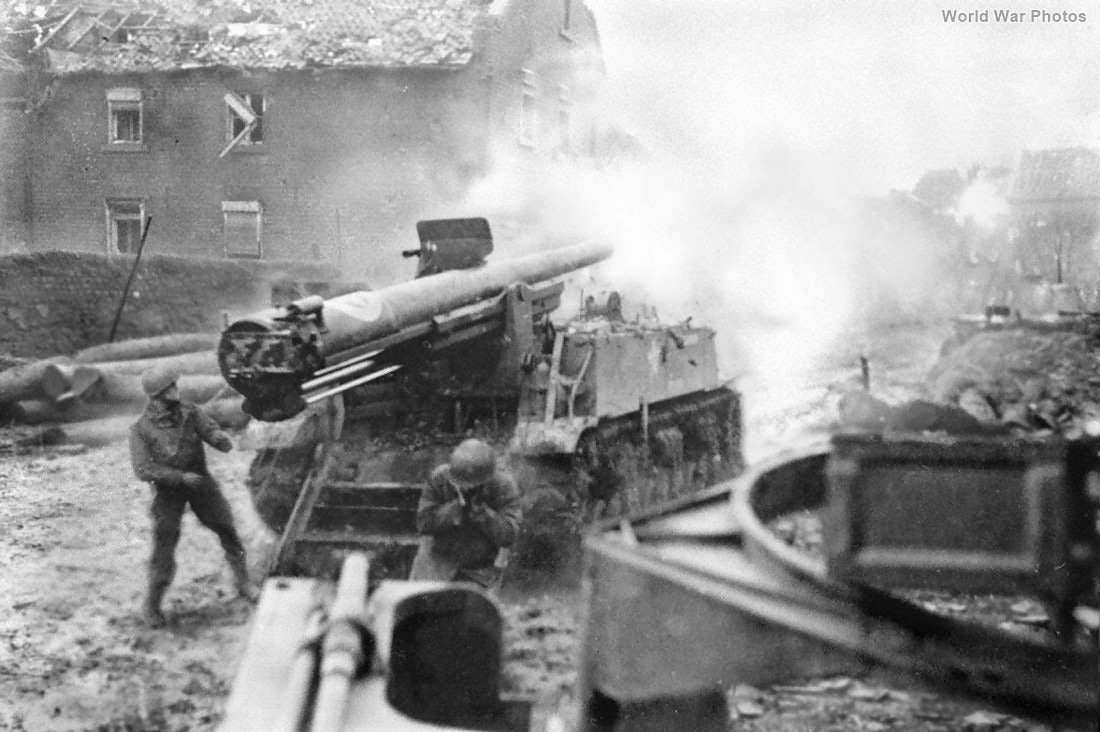
 The most pressing problem was how to get tanks, tank destroyers, and antitank guns into town before the Germans could chase us out with their tanks. The engineer said it would take at least 24 hours to open the underpass.
The most pressing problem was how to get tanks, tank destroyers, and antitank guns into town before the Germans could chase us out with their tanks. The engineer said it would take at least 24 hours to open the underpass.
We had attached to the battalion a platoon of tanks, a platoon of tank destroyers, and a platoon of AT guns from the regimental AT Co, and we didn’t want to be without these weapons any longer than necessary. The tank platoon leader was given a strong infantry patrol and he personally reconnoitered the embankment. He finally found a spot where he said he could get at least three tanks over before the low ground near the embankment became too cut up to move anything. Of course, he said, the far bank is so steep that I may turn over going down it but if I go fast enough maybe I will make a complete somersault and be all right. We decided to risk it with two tanks and to wait for the underpass for the others. We also organized three bazooka teams from each of the AT platoons and sent them right along with the rifle companies.
The detailed plan for the assault called for a long air and artillery bombardment on the morning of Oct 13. The fighter bombers would bomb anywhere in the city except within 500 yards of the railroad tracks in our sector.
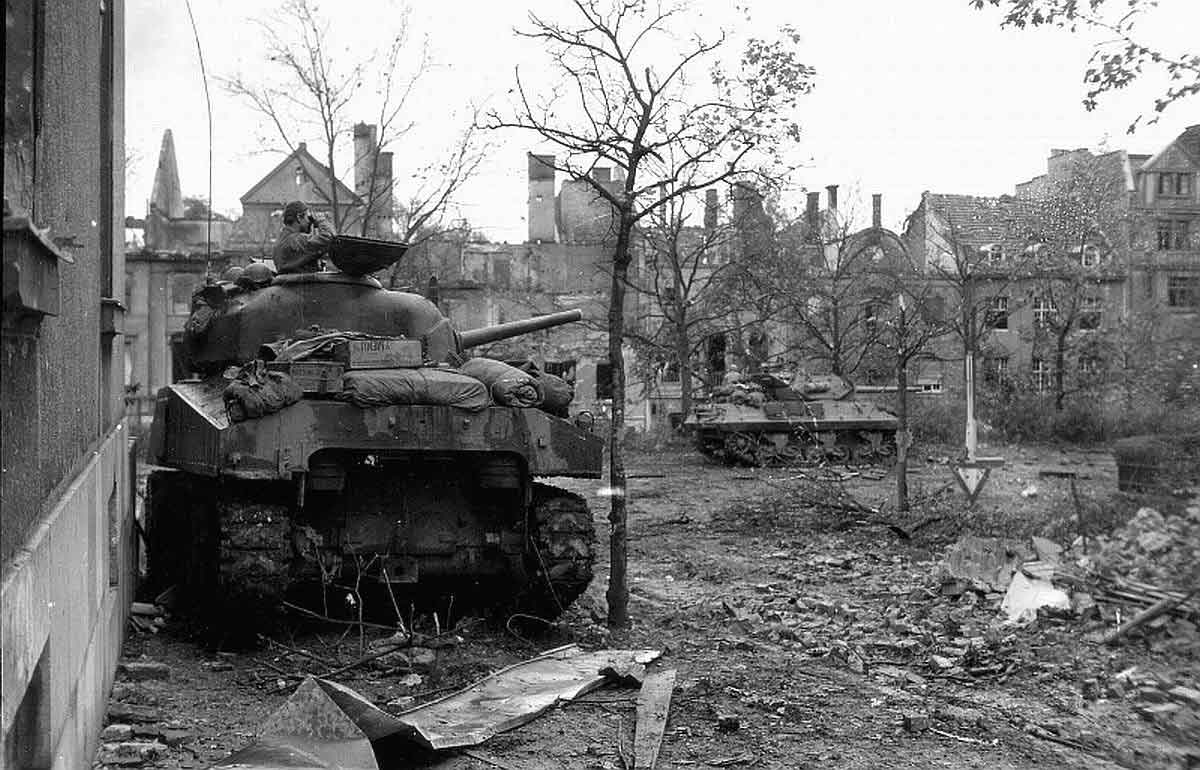 The artillery would start on a line 100 yards from the tracks with the light guns and the mediums (75-MM & 105-MM) and heavies would cover from 300 yards to 500 yards (155-MM & 8 Inch) from the tracks. Our own mortars would paste the area from the tracks to the artillery line 100 yards beyond.
The artillery would start on a line 100 yards from the tracks with the light guns and the mediums (75-MM & 105-MM) and heavies would cover from 300 yards to 500 yards (155-MM & 8 Inch) from the tracks. Our own mortars would paste the area from the tracks to the artillery line 100 yards beyond.
Jump-off was set for 0930 at which time all artillery would lift 200 yards and the air would stop except for targets marked by colored smoke. It sounded fairly good to us but we still were not satisfied since the most ticklish operation was to get the infantry across the railroad embankment, and that was where the least stuff would fall. So each infantryman was given a hand grenade which he was to throw over the embankment at exactly 0930.
After much checking of last-minute details throughout the night, we waited for the show to begin on the morning of Oct 13. The bombardment was most satisfactory, everyone was in position along the tracks, and at 0930 about 1000 hand grenades were heaved over the bank.
Immediately Easy and Fox Cos scrambled across firing every weapon they had. It was actually about one-half hour later before any small arms fire was returned by the Germans.
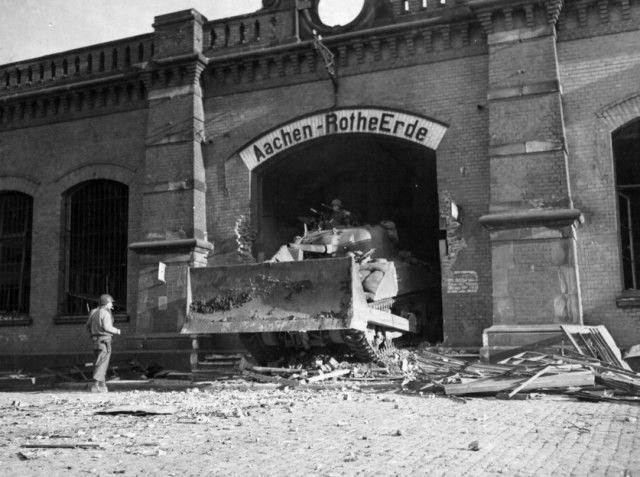 Almost immediately, however, we began to find civilians holed up in cellars and too frightened to talk at all. They were quickly rounded up and evacuated to the regiment. Fox Co had been instructed to stay clear of the built-up area, head north until they reached their zone, and then turn west. Easy Co was to clear all the buildings east of Adalbertsteinweg and north of the tracks. Fox found quite a built-up area in their zone northeast of the cemetery and this slowed them down considerably.
Almost immediately, however, we began to find civilians holed up in cellars and too frightened to talk at all. They were quickly rounded up and evacuated to the regiment. Fox Co had been instructed to stay clear of the built-up area, head north until they reached their zone, and then turn west. Easy Co was to clear all the buildings east of Adalbertsteinweg and north of the tracks. Fox found quite a built-up area in their zone northeast of the cemetery and this slowed them down considerably.
By mid-afternoon, Easy and Fox still had not reached the line that was to allow George Co to be committed. However, we had found that by knocking down doors and blowing out part of the walls of a station, just to the west of the underpass that we could get all our vehicles under the embankment through the station.
And since George had no desire to stay in their foxholes in the swampy ground along the embankment for another night when there were houses (however battered) just across it, they were allowed to cross during the afternoon and clear enough space so we could use the station to get the vehicles into town.
We quickly learned that in street fighting strange to relate, one should stay out of the street. In Aachen, most of the buildings abut against each other. We blew holes through the walls to avoid going into the street in getting from house to house. We used great quantities of dynamite, beehives, and bazooka ammunition in blowing these holes.
Early on the 14, the attack again jumped off. We were now attacking to the west and since the artillery was emplaced south of the town and was firing parallel to our front. This allowed the artillery to fire very close in front of us without danger from short rounds. We found that we could drop shells into the same block where we were working. With fuze delay, the shells would penetrate one or more floors before exploding and the Germans simply would not stay in the building with that coming in and we could move them down as they fled from the buildings.
At about 1200, Fox Co reached the point where it was to contact the 3/26. They reported that they could not go forward until the Battalion appeared because the Germans were trying to get around their right flank and they had to leave two platoons facing north until a juncture could be made. In the meantime, Easy and George closed up. The situation was reported to the regiment and we were told to hold where we were because there was a terrific battle going on for the hills east of the city. We were also warned to be ready to defend to the east in case a breakthrough was made by the Germans attacking the 16-IR and the 18-IR.
Of course, our sister regiments held their positions but it was not clear until late in the evening that they had repulsed the attack. In the meantime, we went over to check the proposed juncture point and found that Germans were indeed just across the street instead of our 3rd Battalion and that they had just destroyed one of our AT guns with Panzerschreck fire. Since we had a cemetery on which to orient ourselves we were certain that we were at the correct point. This information was given to the regiment. During the night the 3/26 Commander personally checked his left company and found it several 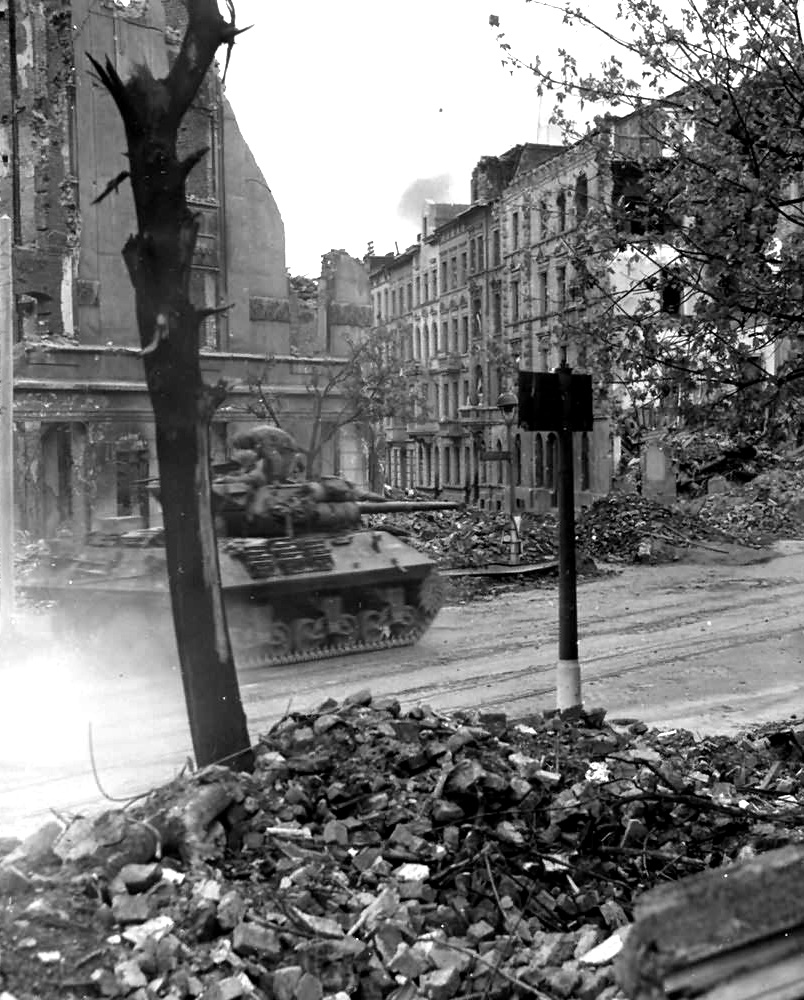 blocks north of the junction point. He directed that company to make the juncture, which was done early on the 15 and the attack then proceeded.
blocks north of the junction point. He directed that company to make the juncture, which was done early on the 15 and the attack then proceeded.
October 15, 1944
During the night of Oct 14/15, two German planes circled very low over the city and dropped many packages of food and cigarettes as well as leaflets carrying greetings and exhortations to the gallant defenders of Aachen. The only slip-up was that most of these packages fell within our lines while the leaflets blew into the German lines. We were quite appreciative of the German cigarettes since that item was in as short supply as gasoline.
About this time George Co uncovered what appeared to be a colossal pillbox or blockhouse. After driving the defenders inside and sealing the two doors with machine-gun fire, the company commander approached with his interpreter and demanded the surrender of the occupants. He got no reply, so he had a flame thrower brought up. The interpreter then yelled that if they did not immediately surrender the flame thrower would go into action. Still, no reply, so the operator tried to get the flame thrower lit but did not succeed.
By this time everyone was getting rather jumpy, not knowing when a burst from a German Burp gun or a hand grenade from inside would end negotiations. However, the company commander took out a box of matches and after fumbling several got the flame thrower ignited and squirted a jet in a door which appeared to be closed by baffles only. There was immediate action inside so the flame was stopped. A German captain came out to discuss terms of surrender. He was told there could be no discussion, either he surrendered immediately or he would get roasted.
Immediately thereafter about 200 soldiers and over 1000 civilians began coming out. Inspection showed the structure to be a three-storied air-raid shelter with walls about 15 feet thick. We ran into two more of these shelters later but did not have to repeat the flame thrower routine on them to get a big haul of prisoners.
At about dusk, a counterattack was launched against George Co. This attack came down Hindenburgstrasse (note: the Hindenburgstrasse was renamed Theaterstrasse in 1945) and penetrated a couple of blocks down Zollernstrasse.
After about two hours of brisk fighting, the penetration was sealed off and the line restored. We had lost one TD, one AT gun, and one heavy machine gun.

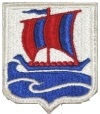 On the 16, we were again held up because of the critical battle going on to the east of the city. However, late on the 16, patrols from the 30-ID made contact with the 18-IR and a short time later the gap was actually closed thus encircling Aachen completely. This was only six days after the delivery of the ultimatum. A few days prior to the 16, one 155-MM SP gun had been attached to the battalion. At the time I was pointedly reminded that this was very valuable equipment and that no ‘accident’ should befall it. Consequently, we had kept it out of harm’s way in the eastern part of town.
On the 16, we were again held up because of the critical battle going on to the east of the city. However, late on the 16, patrols from the 30-ID made contact with the 18-IR and a short time later the gap was actually closed thus encircling Aachen completely. This was only six days after the delivery of the ultimatum. A few days prior to the 16, one 155-MM SP gun had been attached to the battalion. At the time I was pointedly reminded that this was very valuable equipment and that no ‘accident’ should befall it. Consequently, we had kept it out of harm’s way in the eastern part of town.
During the enforced delay on the 16, we located what appeared to be a pillbox near the theater on the Hindenburgstrasse. We held the east side of the Wilhelmstrasse. The Zollernstrasse entered the Wilhelmstasse just south of the Hindenburgstrasse. The houses along the east side of the Wilhelmstrasse prevented our placing direct fire down the Hindenburgstrasse without at the same time exposing the weapon to crossfire down the Wilhelmstrasse.
We moved a TD into a courtyard behind the bouse facing the Hindenburgstrasse and knocked a hole in the brick walls. While this was going on we moved tanks up the streets on either flank to fire into the houses directly across from this point and then sent one infantry platoon across to clear the first house or two to prevent any bazooka from firing on the TD position.
 Up until this time, the Germans had been running tanks back and forth across the Hindenburgstrasse and all we could do was chase them with artillery and mortar fire. As soon as the hole was made the TD started firing at the cross streets down the Hindenburgstrasse to discourage any tank from getting into position to fire back through our hole-in-the-wall. After about a half-hour of this, we brought up the 155-MM SP gun and had it fire some dozen rounds into the pillbox, the theater, and cross streets in between. The firing was quite spectacular and satisfying from our viewpoint. We found later that the pillbox was a tank and that it was completely destroyed, and that one of our random shots into side streets had caught a tank just as it was nosing around a building to shoot in our direction. The German Commander of the city, after his capture, claimed that the use of such a gun at such close range was barbarous and should be outlawed.
Up until this time, the Germans had been running tanks back and forth across the Hindenburgstrasse and all we could do was chase them with artillery and mortar fire. As soon as the hole was made the TD started firing at the cross streets down the Hindenburgstrasse to discourage any tank from getting into position to fire back through our hole-in-the-wall. After about a half-hour of this, we brought up the 155-MM SP gun and had it fire some dozen rounds into the pillbox, the theater, and cross streets in between. The firing was quite spectacular and satisfying from our viewpoint. We found later that the pillbox was a tank and that it was completely destroyed, and that one of our random shots into side streets had caught a tank just as it was nosing around a building to shoot in our direction. The German Commander of the city, after his capture, claimed that the use of such a gun at such close range was barbarous and should be outlawed.
The situation on the hills east of town was again restored by the night of the 16, and we were allowed to proceed with the attack on the 17. Our zone widened considerably to both the north and south as soon as we crossed the Wilhelmstrasse. Also, enemy resistance became even more fanatical. During the 17, the 1106-EC (Group) which had been covering the south approaches to town moved its right battalion about 1000 yards to the north to contact our left flank along the Wilhelmstrasse underpass. This removed a considerable threat from that flank.
(Note) Hindenburgstrasse and Paul von Hindenburg Strasse were and still are common in Germany. The name was used in honor of (Reichspräsidenten) Paul von Hindenburg (1847–1934) President of the Reich. This street became the Hindenburgstarsse on Aug 1, 1915, but on Dec 1, 1944, the city council decided to change several street names in the city, and the Hindenburgstrasse became the Theaterstrasse.
Early on the 18, Charlie Co was attached to the battalion and was placed in the attack in the north part of our zone. About this time we were forcibly reminded that everything must be searched thoroughly. George Co began to get rifle shots from behind their lines. After about two hours of careful searching, the source of the shots was located in a church steeple. Investigation revealed that the church had been looked into but that the tower had been neglected.
 Tanks and TD’s fired at the tower but had little effect, so the 155-MM gun was brought up again and blasted the tower apart with one shot. The tower was found to be a heavily concreted Observation Post. Since the engineers were not required to move to the west from the original point of contact at the underpass we had to protect our left flank by having George Co bend back to that vicinity. During the night of the 18, George Co became so extended that something had to be done. The 2/110-IR (28th Infantry Division), was attached to the 1-ID for a defensive role only. They were given the mission of holding ground captured by the 26-IR. They were placed on our south flank and relieved part of George Co during the night of 18-19 October. Thereafter they would periodically take over part of the ground cleared by George Co thus allowing the Company to concentrate for further advance.
Tanks and TD’s fired at the tower but had little effect, so the 155-MM gun was brought up again and blasted the tower apart with one shot. The tower was found to be a heavily concreted Observation Post. Since the engineers were not required to move to the west from the original point of contact at the underpass we had to protect our left flank by having George Co bend back to that vicinity. During the night of the 18, George Co became so extended that something had to be done. The 2/110-IR (28th Infantry Division), was attached to the 1-ID for a defensive role only. They were given the mission of holding ground captured by the 26-IR. They were placed on our south flank and relieved part of George Co during the night of 18-19 October. Thereafter they would periodically take over part of the ground cleared by George Co thus allowing the Company to concentrate for further advance.
By nightfall, Oct 19, we had captured the Cathedral.
At 0730, on Oct 20, the attack was continued. Resistance in the south was sporadic, but in the north, it was quite strong, particularly in the vicinity of the Technical High School in the Fox Co’s Zone. Early on the 21, the attack was resumed. By about 1000 we had captured several hundred troops in the Technical High School and had closed up to the railroad tracks on the west edge of the city. We were then told to continue the attack for about 500 yards to the west of the tracks. We quickly laid on a show to get across the embankment that resembled somewhat the one we used to get into the city at the beginning of the assault.
The commander of the battalion from the 28-ID, when he saw this attack across the embankment said: Well I’ll be damned, so that’s the way it should be done. We cleared the area west of the embankment with little difficulty, picking up a few hundred more prisoners. In the meantime, the German Commander surrendered himself and 500 men at 1205. These were all the garrison that he knew about but we picked up over 1000 others before the day was over. In all, over 5600 soldiers were captured during the Aachen operations. The total losses from all causes in the 2nd Battalion and attached units throughout the entire Aachen operation were less than 100. The slow thorough methods employed and the constant stress laid upon the use of all available firepower paid off in extremely low casualties for a tough grueling battle.
Additional Sources
303rd Bomber Group
Gen George C. Marshall Foundaition
World War Two Photos
German Flyer Translation
Obverse: Three young American soldiers under the protection of a white flag marched into the town of Aachen – already half-destroyed – carrying the last ultimatum. For weeks the town of Aachen had been in the firing line of the 1st American Army. Since October 16th, Aachen has been encircled. The Nazi Leaders and the German High Command have decided to defend the town of Aachen even in the face of hopelessly superior might, right to the bitter end. The hour of decision came. ‘The American forces have now completely encircled Aachen. They have enough bombers and artillery to destroy the town completely if necessary. The town will be taken by us … either by immediate unconditional surrender or by ruthless air assault.’ … these are the words with which the ultimatum of the Commander of the 1st American Army began, which was presented on the morning of October 8th to the mayor of the town and the commander of the German garrison. The 24-hour ultimatum was rejected by the Germans – again on the supreme order of the Fuhrer’s headquarters. … And so die Aachen. On the Monday 9th of October 1944 at 1030 the battle of the annihilation began. Under its weight, the town of Aachen was razed to the ground. for days, German soldiers fought tooth and nail in the smoldering ruins of Aachen, but Aachen is no more. What is the use? What has been gained? At the cost of one of the oldest German cities, at the cost of the lives …
Reverse: … of thousands of German soldiers, Hitler and Himmler have prolonged the war for a few days. Is this a German victory? A success? A triumph? What is the Lesson? The lesson is this: Yes by refusing to surrender a lost and surrounded position, by fighting in every German town as they have fought in Aachen – by such murderous madness, Hitler, Himmler and their regime can gain a lease of life for a few more days. but the price of this lease of life, thus bought by the regime, is the total destruction of German towns, cities, villages, the useless sacrifice of German men, and the indescribable misery for all, after the collapse which the leaders can postpone but not prevent. Yesterday it was Aachen … Tomorrow it will be Düsseldorf – or Cologne, Trier, or Münster. Then: Mainz, Stuttgart, Kassel, Hanover, Bremen. Three young Americans under the protection of the white flag will present the German commander with the last ultimatum ‘Honourable Surrender or Complete Destruction?’ And then? What will happen? In accordance with the wish of Hitler and Himmler, will all German cities be razed to the ground just like Aachen? Or will at the very last moment, Germany take matters into her own hands against the wishes of the nazi leaders and force the immediate honorable surrender of her towns???
You have the choice











